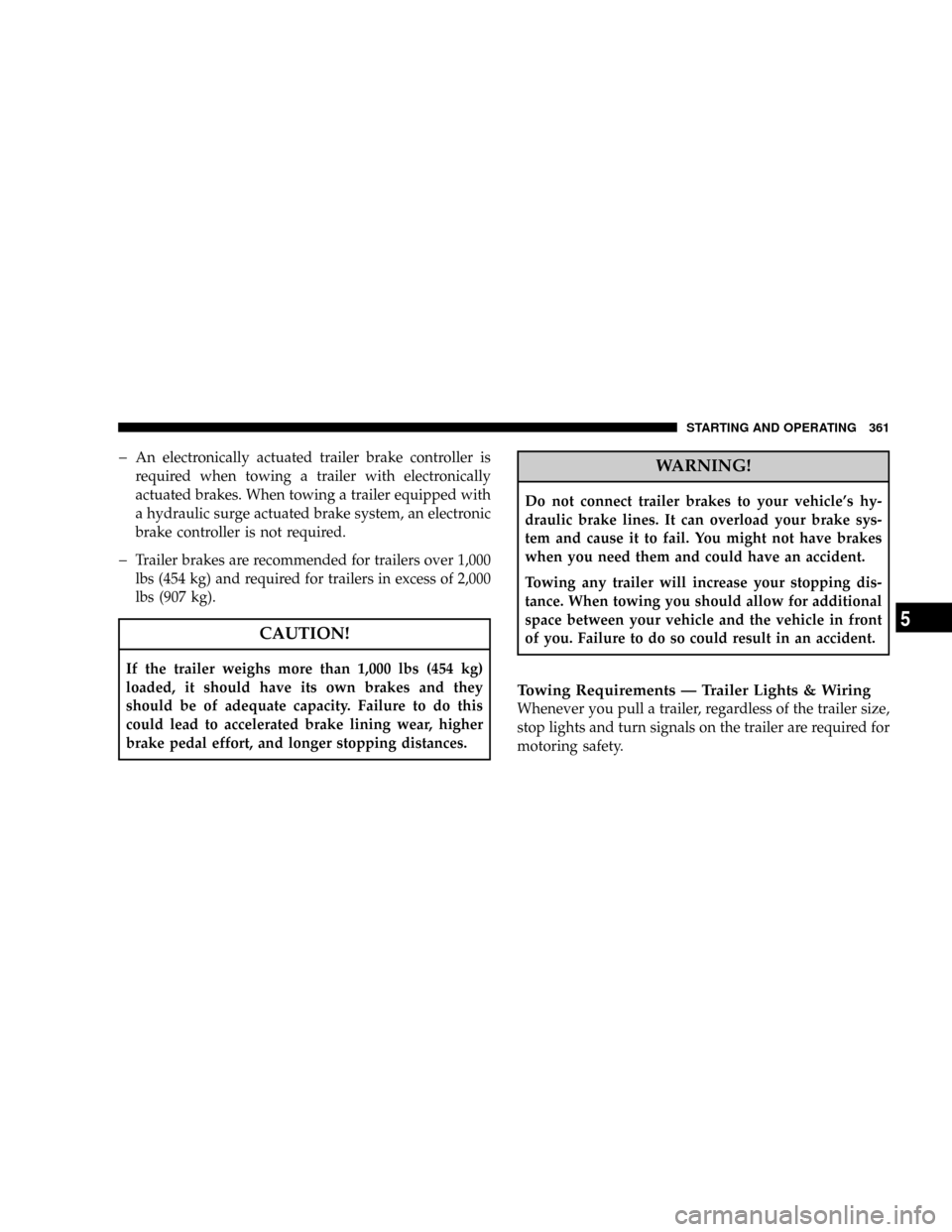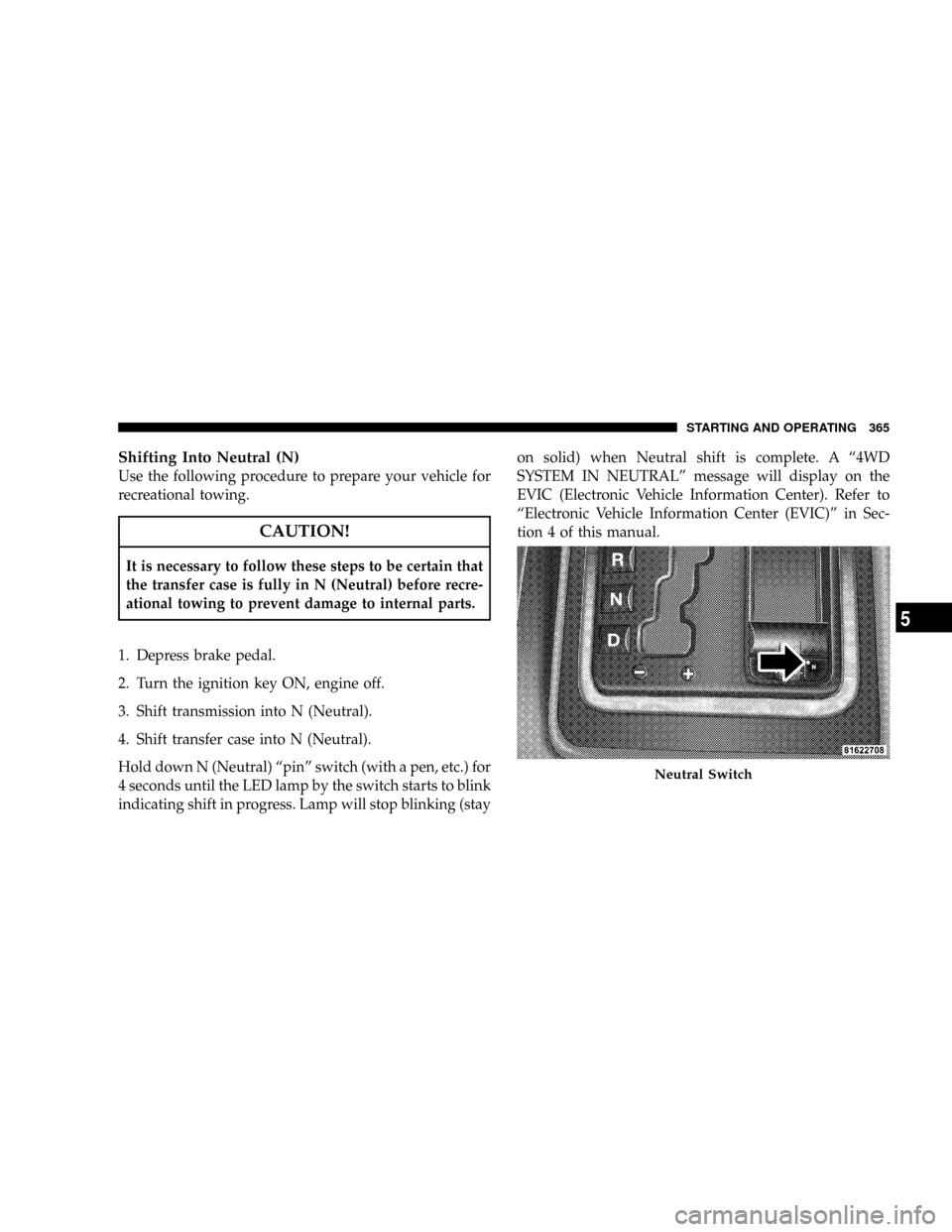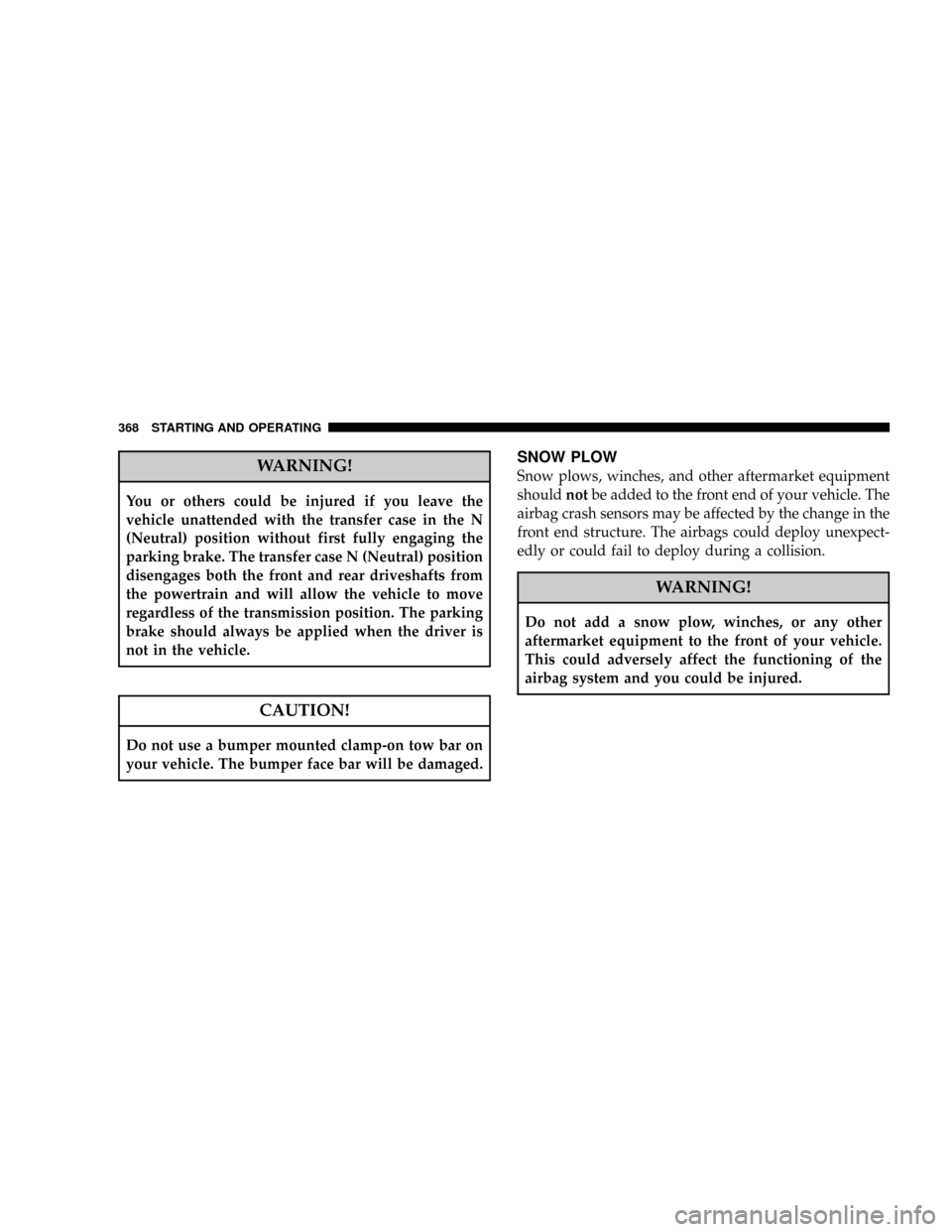JEEP GRAND CHEROKEE 2008 WK / 3.G Owners Manual
Manufacturer: JEEP, Model Year: 2008, Model line: GRAND CHEROKEE, Model: JEEP GRAND CHEROKEE 2008 WK / 3.GPages: 490, PDF Size: 6.86 MB
Page 361 of 490

þAn electronically actuated trailer brake controller is
required when towing a trailer with electronically
actuated brakes. When towing a trailer equipped with
a hydraulic surge actuated brake system, an electronic
brake controller is not required.
þTrailer brakes are recommended for trailers over 1,000
lbs (454 kg) and required for trailers in excess of 2,000
lbs (907 kg).
CAUTION!
If the trailer weighs more than 1,000 lbs (454 kg)
loaded, it should have its own brakes and they
should be of adequate capacity. Failure to do this
could lead to accelerated brake lining wear, higher
brake pedal effort, and longer stopping distances.
WARNING!
Do not connect trailer brakes to your vehicle's hy-
draulic brake lines. It can overload your brake sys-
tem and cause it to fail. You might not have brakes
when you need them and could have an accident.
Towing any trailer will increase your stopping dis-
tance. When towing you should allow for additional
space between your vehicle and the vehicle in front
of you. Failure to do so could result in an accident.
Towing Requirements Ð Trailer Lights & Wiring
Whenever you pull a trailer, regardless of the trailer size,
stop lights and turn signals on the trailer are required for
motoring safety.
STARTING AND OPERATING 361
5
Page 362 of 490

The Trailer Tow Package may includea4and7pin
wiring harness. Use a factory approved trailer harness
and connector.
The electrical connections are all complete to the vehicle
but you must mate the harness to a trailer connector.
Refer to the following illustrations.
Towing Tips
Before setting out on a trip, practice turning, stopping
and backing the trailer in an area away from heavy
traffic.
4 - Pin Connector
7- Pin Connector
362 STARTING AND OPERATING
Page 363 of 490

Towing Tips Ð Automatic Transmission
The ªDº range can be selected when towing. However, if
frequent shifting occurs while in this range, the ºTow/
Haulº mode (if equipped) or a lower gear range should
be selected.
NOTE:Using the ºTow/Haulº mode (if equipped) or a
lower gear range while operating the vehicle under
heavy operating conditions will improve performance
and extend transmission life by reducing excessive shift-
ing and heat build up. This action will also provide better
engine braking.
The automatic transmission fluid and filter should be
changed if you REGULARLY tow a trailer for more than
45 minutes of continuous operation. Refer to the ªMain-
tenance Scheduleº in Section 8 of this manual for trans-
mission fluid change intervals.
NOTE:Check the automatic transmission fluid level
before towing.
Towing Tips Ð Electronic Speed Control (If
Equipped)
þ
Don't use in hilly terrain or with heavy loads.
þWhen using the speed control, if you experience speed
drops greater than 10 mph (16 km/h), disengage until
you can get back to cruising speed.
þUse speed control in flat terrain and with light loads to
maximize fuel efficiency.
Towing Tips Ð Cooling System
To reduce potential for engine and transmission over-
heating, take the following actions:
þCity Driving
When stopped for short periods of time, put transmission
in N (Neutral) and increase engine idle speed.
þHighway Driving
Reduce speed.
STARTING AND OPERATING 363
5
Page 364 of 490

þAir Conditioning
Turn off temporarily.
þRefer to Cooling System Operating information in the
Maintenance section of this manual for more informa-
tion.
RECREATIONAL TOWING (BEHIND
MOTORHOME, ETC.)
Towing ± 2WD Models
Recreational towing is allowed ONLY if the driveshaft
is removed.Towing with the rear wheels on the ground
while the driveshaft is connected can result in severe
transmission damage.
Towing Ð Quadra-Trac I (Single-Speed Transfer
Case) 4WD Models
Recreational towing is not allowed.This model does not
have a N (Neutral) position in the transfer case.
Towing Ð Quadra±Trac II /Quadra±Drive II 4WD
Models
CAUTION!
Front or rear wheel lifts should not be used. Internal
damage to the transmission or transfer case will occur
if a front or rear wheel lift is used when recreational
towing.
NOTE:The transfer case must be in the N (Neutral)
position, and the transmission must be in the P (Park)
position for recreational towing.
364 STARTING AND OPERATING
Page 365 of 490

Shifting Into Neutral (N)
Use the following procedure to prepare your vehicle for
recreational towing.
CAUTION!
It is necessary to follow these steps to be certain that
the transfer case is fully in N (Neutral) before recre-
ational towing to prevent damage to internal parts.
1. Depress brake pedal.
2. Turn the ignition key ON, engine off.
3. Shift transmission into N (Neutral).
4. Shift transfer case into N (Neutral).
Hold down N (Neutral) ªpinº switch (with a pen, etc.) for
4 seconds until the LED lamp by the switch starts to blink
indicating shift in progress. Lamp will stop blinking (stayon solid) when Neutral shift is complete. A ª4WD
SYSTEM IN NEUTRALº message will display on the
EVIC (Electronic Vehicle Information Center). Refer to
ªElectronic Vehicle Information Center (EVIC)º in Sec-
tion 4 of this manual.
Neutral Switch
STARTING AND OPERATING 365
5
Page 366 of 490

5. Start engine.
6. Shift transmission into D (Drive).
7. Release brake pedal and ensure that there is no vehicle
movement.
8. Shut the engine off.
9. Shift transmission into P (Park).
10. Place the ignition key in the OFF position, and
remove key.
11. Apply parking brake.
12. Attach vehicle to the tow vehicle with tow bar.
13. Release parking brake.CAUTION!
Transmission damage may occur if the transmission
is shifted into P (Park) with the transfer case in N
(Neutral) and the engine running. With the transfer
case in N (Neutral) ensure that the engine is OFF
prior to shifting the transmission into P (Park) (refer
to steps7±8above).
366 STARTING AND OPERATING
Page 367 of 490

Shifting Out Of Neutral (N)
Use the following procedure to prepare your vehicle for
normal usage.
1. Depress brake pedal.
2. Turn the ignition key ON, engine off.
3. Shift transmission into N (Neutral).
4. Shift transfer case out of N (Neutral).
Hold down N (Neutral) ªpinº switch (with a pen, etc.) for
4 seconds until the LED lamp by the switch starts to blink
indicating shift in progress. Lamp will stop blinking (go
out) when shift is complete. The ª4WD SYSTEM IN
NEUTRALº message will no longer be displayed on the
EVIC (Electronic Vehicle Information Center). Refer to
ªElectronic Vehicle Information Center (EVIC)º in Sec-
tion 4 of this manual.5. Shift transmission into P (Park).
6. Start the engine.
7. Shift transmission into D (Drive).
NOTE:
When shifting out of transfer case N (Neutral),
turning the engine OFF may be required to avoid gear clash.
Neutral Switch
STARTING AND OPERATING 367
5
Page 368 of 490

WARNING!
You or others could be injured if you leave the
vehicle unattended with the transfer case in the N
(Neutral) position without first fully engaging the
parking brake. The transfer case N (Neutral) position
disengages both the front and rear driveshafts from
the powertrain and will allow the vehicle to move
regardless of the transmission position. The parking
brake should always be applied when the driver is
not in the vehicle.
CAUTION!
Do not use a bumper mounted clamp-on tow bar on
your vehicle. The bumper face bar will be damaged.
SNOW PLOW
Snow plows, winches, and other aftermarket equipment
shouldnotbe added to the front end of your vehicle. The
airbag crash sensors may be affected by the change in the
front end structure. The airbags could deploy unexpect-
edly or could fail to deploy during a collision.
WARNING!
Do not add a snow plow, winches, or any other
aftermarket equipment to the front of your vehicle.
This could adversely affect the functioning of the
airbag system and you could be injured.
368 STARTING AND OPERATING
Page 369 of 490

WHAT TO DO IN EMERGENCIES
CONTENTS
mHazard Warning Flashers.................370
mIf Your Engine Overheats.................371
mJacking And Tire Changing................372
NJack Location........................372
NSpare Tire Stowage....................373
NSpare Tire Removal....................373
NPreparations For Jacking................374NJacking Instructions....................375
mJump Starting.........................378
mEmergency Tow Hooks Ð If Equipped........381
mTowing A Disabled Vehicle................382
N2WD Models Only....................382
N4WD Models Only....................382
6
Page 370 of 490

HAZARD WARNING FLASHERS
Your vehicle's hazard warning flasher is an emergency
warning system. When you activate it, all front and rear
directional signals will flash intermittently. Use it when
your vehicle is disabled on or near the road. It warns
other drivers to steer clear of you and your vehicle. This
is an emergency warning system, not to be used when the
vehicle is in motion.
To activate the warning flashers, press the button on the
upper switch bank. To turn the warning flashers off,
press the button again.
NOTE:With extended use, the flasher may run down
your battery.
Hazard Warning Switch
370 WHAT TO DO IN EMERGENCIES